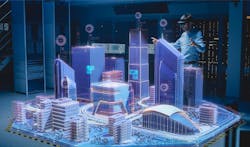What AEC professionals should know about digital twins
By Quinn Purcell, Managing Editor
The elusive “digital twin.” A virtual space that doesn’t quite live in the metaverse, but is definitely more than just your average BIM model. While their use cases are continually developing, a growing number of AEC firms and building owners are finding value in implementing digital twins to unify design, construction, and operational data.
But what are the benefits, both by sector and overall? And where do architects, engineers, and construction professionals fit in?
AEC Firms Engaging With Digital Twin Tools
A digital twin is the digital replica of a physical building that holds its information in one place—like a “shoebox.” Though they can be two-dimensional or 3D, digital twins offer a tell-all locale for a facility’s systems, from electrical work to its structural layout. More importantly, digital twins pave the way for analytics-driven action.
With some building owners beginning to include digital twin requirements in project RFPs, AEC firms are beginning to build digital twins for their clients, according to Robert Bray, VP and General Manager, Autodesk Tandem.
“This is creating new business opportunities for AEC firms, driving meaningful conversations about outcomes and data, and is creating the potential for longer term engagements with their clients,” says Bray.
As AEC firms engage with building digital twins, they can help advance their clients’ initiatives like monitoring and meeting sustainability goals—as well as gain knowledge to plan, design, and build better themselves in the future.
Artificial intelligence
With the influx of artificial intelligence-influenced workflows, digital twins could soon be getting smarter as well. Predictive models might analyze construction data or building conditions to better manage assets, according to Tiago Ricotta, Customer Experience Team Manager at Trimble, an industrial technology company.
“This could give really good inputs for early conceptual design,” he adds.
Digital twins as a live link
For an organization looking to create a digital twin for its building—or AEC firms beginning to build digital twins for their clients—clear objectives should first be set. Without this, it can be difficult to establish what level of detail is needed and whether or not there will be a live link between the model and real life.
“A digital model that nobody accesses or that doesn’t provide information doesn't have many purposes,” says Ricotta. “It should be designed in a way that helps gather the information that will help people understand and use the data it provides.”
This data could track systems in the building, like water and energy usage, with sensors installed that connect it to the digital twin. The twin can map out areas for maintenance teams, providing vision and training before entering restricted/dangerous areas. Other insights from discovering potential issues to reviewing trends would be consolidated into one place—making the digital twin a one-stop shop for facility management.
Enhancing User Experience for Digital Twin Users
While the benefits behind the scenes are plentiful, one of the biggest advantages of buildings with a digital twin is enhancing the user experience for its occupants. Currently, corporate offices are the largest sector that has embraced digital twins. However, we’re seeing use cases in hospitals and retail environments begin to grow, according to Morten Brøgger, CEO of MapsPeople, an indoor mapping tech company.
Digital twin uses across builder sectors
Across multiple sectors, digital twins can help people connect with space. Some practical examples include:
- Stadium parking. Attending fans have the ability to book a parking space from their phone, and can plan their route inside the stadium before they’ve even left the house.
- Airport traversal. Airline travelers can receive real-time airport updates as they’re walking to their gate, from restaurant wait times to flight ETAs.
- Preserving historic buildings. Through Historic Building Information Modeling (HBIM), detailed 3D models of historic buildings aid in preserving heritage, community spaces, and future renovations.
- Navigating large buildings. Walking through hospital wings, university buildings, or convention center show floors could be made easier with indoor mapping.
- Hotels. Hotels can offer accessible routes and services to guests with special mobility needs.
- Corporate office layouts. In a hybrid work-from-home world, employees who may be less familiar with their office’s environment could get a helping hand from digital twins.
- Retail spaces. Retailers can empower shoppers to find products more quickly.
The end goal? Help facility owners and its stakeholders to rectify issues before they become problems, and make decisions based on data rather than guesswork.
